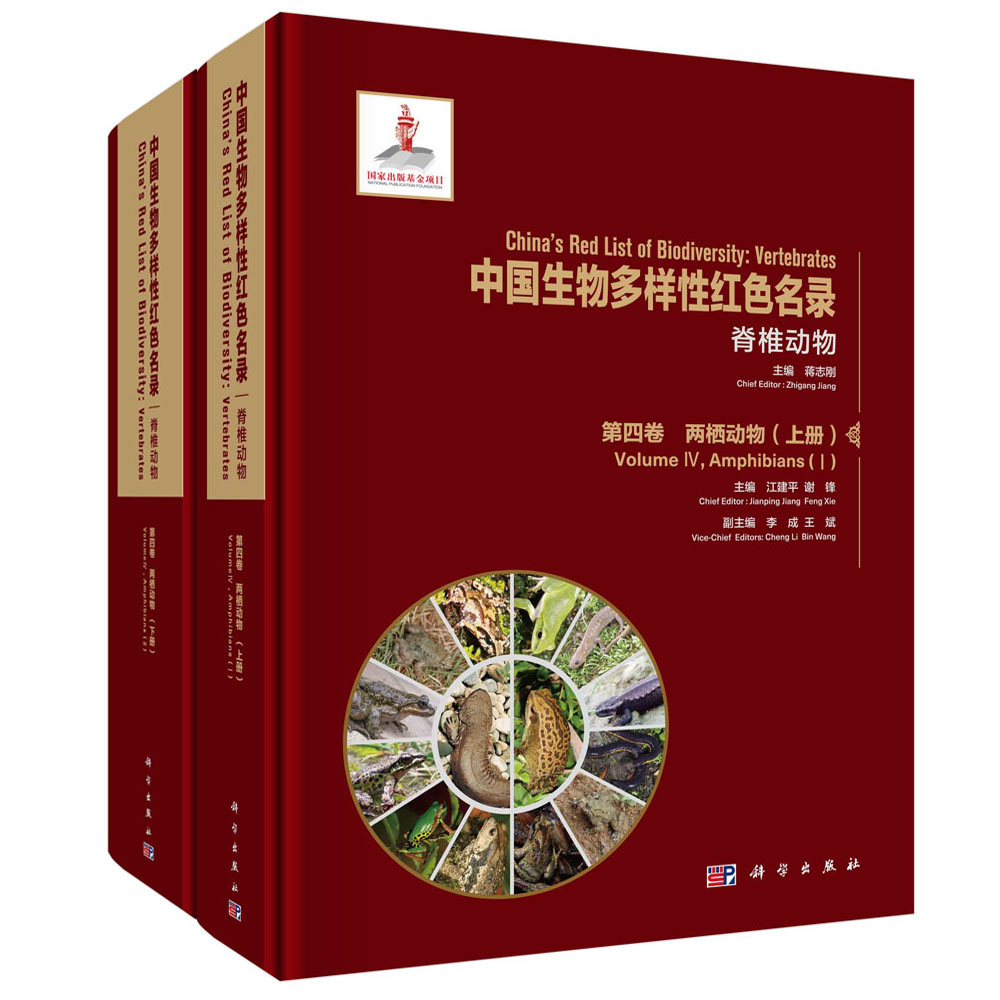
出版社: 科学
原售价: 1098.00
折扣价: 867.50
折扣购买: 中国生物多样性红色名录(脊椎动物第4卷两栖动物上下汉英对照)(精)
ISBN: 9787030692368

总论General Introduction
1两栖动物的演化历史与现状
四足动物 (tetrapod,包括两栖类、爬行类、哺乳类和鸟类 )起源于肉鳍鱼类 (sarcopterygian),是脊椎动物演化史上极为重要的演化事件 (Clack, 2012)。这一由水到陆的转变所带来的对呼吸、取食、听觉、视觉和行为方式上的挑战对脊椎动物的身体结构产生了深远影响 (Brazeau and Ahlberg, 2006; Schoch, 2014)。大量实体和遗迹化石记录的发现表明,四足动物起源于泥盆纪中晚期的浅水区域 (Warburton and Denman, 1961; Clack, 2012; Beznosov et al., 2019),其中,生活在泥盆纪晚期的希望螈类 (elpistostegalian,包括提克塔利克鱼属的 Tiktaalik roseae、希望螈属的 Elpistostege watsoni和潘氏鱼属的 Panderichthys rhombolepis和 P. stolbori)具有多个过渡类型甚至具有四足动物的标志性骨骼特征,如宽扁的头骨、粗壮的髋部骨骼和手指、脚趾骨等 (图 1),被认为是与四足动物亲缘关系最近的肉鳍鱼类 (Daeschler et al., 2006; Shubin et al., 2006, 2014; Cloutier et al., 2020)。早期的四足动物 [如著名的鱼石螈属的 Ichthyostega stensioei、(古 )棘螈属的 Acanthostega gunnari等 ]体型较大,具有更加适应陆地生活的结构特征 (如粗壮的肢骨等 ),然而并不能完全脱离水生环境 (Coates and Clack, 1991; Sanchez et al., 2016; Beznosov et al., 2019)。
作为现生四足动物中最为原始的类群,两栖类具有高度分化的形态特征和多样的发育方式 (变态发育、幼态持续发育、直接发育 ),可以
图 1早期四足动物 (古 )棘螈属与部分肉鳍鱼类代表 (提克塔利克鱼属、真掌鳍鱼属 )复原图 (贾佳修改自 Shubin et al., 2014; Figs. 5, 6)
Evolutionary History and Present Status of Amphibians
Tetrapoda, or four-limbed vertebrates, is a clade that consists of the Amphibia, Reptilia, Mammalia and Aves. The tetrapods are originated from the lobe-finned fishes or sarcopterygians, which represents one of the most significant events in the evolutionary history of vertebrates (Clack, 2012). The water to land transition in living habitats along with the origin of tetrapods imposed challenging impacts on the structures and organizations of vertebrate body in a plethora of aspects, including breathing, feeding, hearing vision, and locomotion, etc. (Brazeau and Ahlberg, 2006; Schoch, 2014). Multiple discoveries of both body and trace fossils of both sarcopterygians and early tetrapods demonstrate that the origin of tetrapods occurred in shallow water environments during the Middle-Late Devonian (Warburton and Denman, 1961; Clack, 2012; Beznosov et al., 2019). Among fossil records of sarcopterygians, the elpistostegalian fishes that lived during the Late Devonian period have been widely regarded as the closest relatives of tetrapods, because several transitional or even iconic characters of tetrapods, including wide and flattened skulls, robust pelvis and presence of digits in the pectoral fin (Figure 1), have been identified in one or several members of the elpistostegalians (Daeschler et al., 2006; Shubin et al., 2006, 2014; Cloutier et al., 2020): Tiktaalik roseae, Elpistostege watsoni and two species of Panderichthys (P. rhombolepis and P. stolbovi). Early representatives of tetrapods, like the famous Ichthyostega stensioei and Acanthostega gunnari, are
Figure 1 Reconstructions of representatives of early tetrapods (Acanthostega) and lobe-finned fishes (Tiktaalik and Eusthenopteron). Jia Jia modified from Shubin et al., 2014 (Figs. 5, 6)
在广阔的栖息环境中生存 (水生、穴居、树栖等 ),是研究四足动物起源的重要现生类群 (Duellman and Trueb, 1986; Vitt and Caldwell, 2014)。传统的林奈分类系统认为两栖纲包含早期的四足动物,但是基于分支系统学的研究认为两栖纲的共同祖先起源于早期的四足动物,并进一步分化为已绝灭的离片椎亚纲 (Temnospondyli)、壳椎亚纲 (Lepospondyli)和现存的滑体两栖亚纲 (Lissamphibia)。离片椎类因其脊椎由多部分椎体和椎弓组成而得名,是一类生活在石炭纪早期至白垩纪早期体型较大的古两栖类;目前已发现 200余属 300余种 (Schoch, 2014)。壳椎类因其脊椎结构简单类似线轴状而得名,是一类生活在石炭纪早期至二叠纪早期体型较小的四足动物;目前发现 60余属 80余种 (Schoch, 2014)。值得一提的是,壳椎亚纲的分类位置仍处于争论中,并且越来越多的证据显示壳椎类是一个并系类群 (Pardo et al., 2017a),部分壳椎类与早期四足动物或者早期羊膜动物亲缘关系密切 (Ruta et al., 2003)。
滑体两栖亚纲包括现生的三个目:蚓螈目 (Gymnophiona),有尾目 (Caudata)和无尾目 (Anura)。这三大类群的最早化石记录均发现于三叠世,分别为科罗拉多晚三叠世的钦利顶螈属 (Chinlestegophis; Pardo et al., 2017b)、马达加斯加早三叠世的三叠蛙属 (Triadobatrachus; Ascarrunz et al., 2016)和吉尔吉斯斯坦中晚三叠世的三叠螈属 (Triassurus; Ivakhnenko, 1978; Schoch et al., 2020)。多数研究认为这三大滑体两栖类具有多个共近裔性状 (如基座型牙齿 ),属于一个单系类群,并于石炭纪晚期起源于离片椎类中的 dissorophoids (Milner, 1988; Ruta and Coates, 2007)。此外,也有研究认为生活于侏罗纪中期至更新世早期已绝灭的异螈目 (Allocaudata),又称阿尔班螈类 (Albanerpetontids),是第四类滑体两栖动物 (Duellman and Trueb, 1986; Matsumoto and Evans, 2018; Daza et al., 2020)。
根据世界两栖动物物种数据库 [Amphibian Species of the World 6.0, an Online Reference; https (2020年 8月 13日查看 )],目前已知世界现生两栖动物物种 8,209种,隶属于 3目 49科 548属。两栖动物是脊椎动物中从水生到陆生的过渡类群,其迁移能力弱,对环境的依赖性强,主要生活于陆地湿润及淡水环境,仅有极少数物种可以适应咸水环境,如海陆蛙 (Fejervarya cancrivora)。不同类型的两栖动物生活于不同的生态环境中,包括不同的陆地 (平原、丘陵、山地、高原 )、水域 (水坑、水田、沟渠、沼泽、池塘、湖泊、江河、缓流和急流 )、植被 (农作物、草地、灌丛、针叶林、阔叶林、针阔叶混交林、高山草甸 )以及不同的气候地带和垂直地带 (图 2~图 6)。两栖动物在演化历程中,经过长期的自然选择适应了多种多样的生态环境。从生态型看,两栖动物有四大类型:水栖型、陆栖型、树栖型和穴居型。两栖动物主要以低等无脊椎动物为食,偶见取食鱼、爬行动物、鸟类和啮齿类。
large in body size, and have morphological traits (e.g. robust limb structures) that are more adaptable for terrestrial environments than their fish ancestors, however they are still largely aquatic (Coates and Clack, 1991; Sanchez et al., 2016; Beznosov et al., 2019).
Amphibians are the most primitive group of extant tetrapods and play a significant role in understanding the origin of tetrapods (Duellman and Trueb, 1986; Vitt and Caldwell, 2014). They are highly diversified in both their morphology and life history strategies (metamorphosis, neoteny and direct development) and, therefore, can take advantage of sources from multiple kinds of liv
从事野生动物研究与保护的科研人员,自然保护区、环境保护、进出口对外贸易、检验检疫等相关各级行政管理部门,高年级研究生,国内大中型图书馆